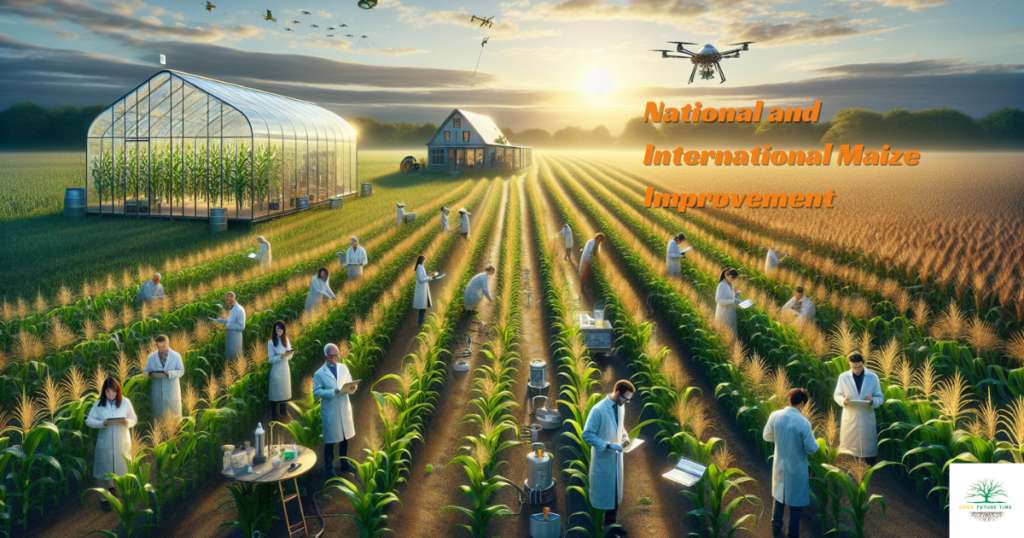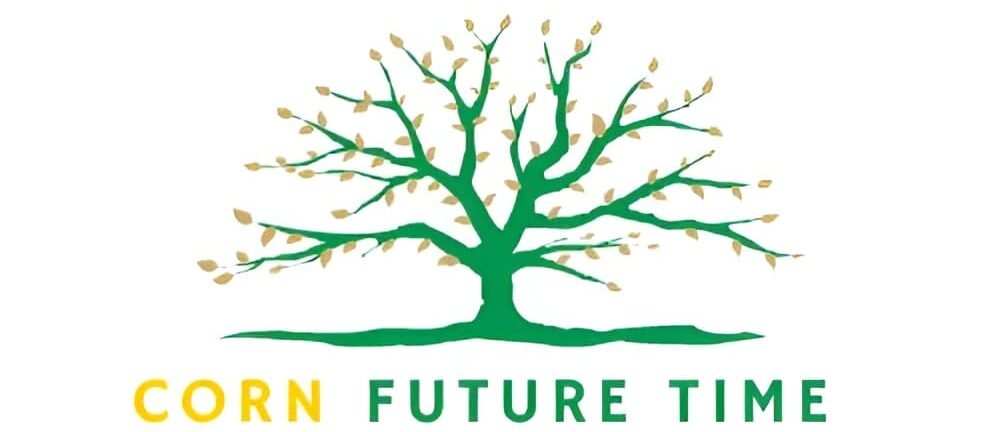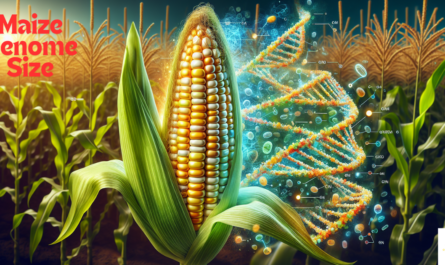
National & International Maize: insight from CIMMYT of This article explores CIMMYT’s contributions to national and international maize improvement. It delves into cutting-edge technologies for crop enhancement, strategies to make maize production more environmentally friendly, and efforts to build capacity in national agricultural systems. National & International Maize Improvement from CIMMYT By examining these aspects, we gain insight into how CIMMYT’s work helps to ensure food security and sustainable agriculture in a rapidly changing world.
Maize Improvement Technologies
CIMMYT has been at the forefront of developing and implementing innovative technologies to enhance maize productivity and resilience. These advancements span various areas, from traditional breeding methods to cutting-edge biotechnology and precision agriculture techniques.
Conventional Breeding Techniques
Conventional breeding techniques have evolved significantly since the early 20th century. Plant breeders now apply Gregor Mendel’s principles of genetic variation and heredity, taking advantage of heterotic, or hybrid vigor, to produce stronger and more productive offspring.
Precision Agriculture
Precision agriculture techniques have been instrumental in accelerating maize improvement. Speed breeding, which uses artificially extended day length, controlled temperatures, and advanced phenotyping technology, allows for up to four crop cycles per year, compared to only two cycles with normal field trials. This significantly accelerates the development of productive and robust varieties.
Data analysis and management have become crucial components of modern breeding programs. New informatics tools, such as the Enterprise Breeding System, help scientists manage, analyze, and apply big data from genomics, field, and lab studies. This has led to more informed decision-making in breeding programs, especially regarding which lines to cross and which populations to advance or discard.
These technological advancements have significantly reduced breeding cycle times. In most maize product profiles, the breeding cycle has been reduced from five or six years to only four years. This acceleration in breeding cycles, combined with improved selection methods and advanced technologies, is helping CIMMYT and its partners develop more resilient and productive maize varieties to meet the challenges of climate change and food security.
Biotechnology and Genetic Engineering
Biotechnology has transformed maize improvement efforts. Since the 1990s, geneticists and breeders have utilized molecular markers, specific regions of the plant’s genome linked to desired traits, to develop detailed genetic maps and sequence crop plant genomes. This has allowed for more precise selection of breeding crosses with the greatest number of desired traits.
Genetic engineering techniques have further expanded the possibilities for maize improvement. Transgenic, a technology that inserts genes from one species into another, has been used since the 1990s to implant traits such as pest resistance and improved nutritional value. More recently, genome editing techniques have emerged, allowing for precise modification of specific DNA sequences to enhance or diminish gene expression.
CIMMYT has made significant strides in implementing these technologies. In Eastern and Southern Africa, 60% of CIMMYT’s maize lines are now developed using advanced technologies that speed up the breeding cycle and improve selection intensity and accuracy. These include doubled haploid technology, high-throughput phenotyping, and genomic selection.
Environmental Sustainability in Maize Production
1) Conservation Agriculture
Conservation agriculture has emerged as a sustainable alternative to conventional maize production practices, particularly in rain fed conditions. This approach encompasses practices that enhance soil conservation, water-holding capacity, and crop yield stability in smallholder farming systems. Conservation agriculture-related practices (CARP) have shown significant improvements in soil fertility, maize yield, and profitability.
Studies have demonstrated that maize yields under CARP interventions (3.98–4.43 Mg ha−1) were significantly higher than those under conventional farming practices (1.84 Mg ha−1). These practices contribute to increased crop yield, income, and soil fertility restoration in agricultural land.
2) Water Use Efficiency
Improving water use efficiency is crucial in the era of climate change. Water use efficiency measures how much biomass a plant can produce using a given amount of water. Strategies to enhance water use efficiency include growing crops with high water use efficiency and implementing efficient irrigation methods.
Drip irrigation has proven to be an effective method for improving water use efficiency in maize production. Compared to conventional border irrigation, drip irrigation has increased maize yield by 14.39% and water use efficiency by 43.48–68.09%. This method has also led to an increase in irrigation water use efficiency by 47.63–70.60% and an economic efficiency increase of 756.58 USD$ hm−1.
3) Soil Health Management
Maintaining soil health is fundamental to sustainable maize production. Several strategies can be employed to support soil health across various climate zones and soil conditions:
Minimize erosion through conservation systems like terracing, contour buffer strips, and windbreaks
Implement no-till or reduced-tillage cropping systems to protect against soil erosion and improve soil structure.
Use cover crops to control erosion, reduce nutrient runoff, suppress weed growth, and increase biological diversity.
Rotate annual crops with perennial forage crops to maintain ground cover and eliminate tillage.
Emphasize natural inputs over synthetic ones for nutrient management, including compost, animal manure, and green manure crops.
By adopting these practices, farmers can work with the land to reduce erosion, maximize water infiltration, improve nutrient cycling, and ultimately enhance the resiliency of their working land.
Capacity Building for National Agricultural Systems
CIMMYT plays a crucial role in strengthening national agricultural systems through various capacity-building initiatives. These efforts focus on empowering scientists, researchers, and agricultural professionals with the knowledge and skills needed to address the challenges in maize production and improvement.
4) Training Programs
CIMMYT, in collaboration with other institutions, offers innovative training programs to enhance the expertise of agricultural professionals. The Advanced Wheat Improvement Course, jointly offered by CIMMYT and Cornell University, provides comprehensive training on recent advances in agricultural plant breeding. This online course, designed for mid-career scientists and graduate students, covers technologies such as genomic selection, selection indices, GWAS analysis, and speed breeding.
Similarly, CIMMYT and IITA have developed the Early Career Maize Breeding Online Course for new and upcoming maize breeders from Africa’s public and private sectors. This course aims to impart research skills and knowledge needed to efficiently use modern breeding methods in maize breeding programs.
5) Knowledge Transfer
These training programs serve as platforms for knowledge transfer, fostering teamwork and interdisciplinary research approaches. Participants gain familiarity with CIMMYT’s and IITA’s current research and breeding objectives, as well as new improved stress-tolerant maize germplasm. This exposure helps in bridging the gap between global research advancements and local agricultural practices.
6) Strengthening Local Research Capabilities
CIMMYT’s capacity-building efforts extend beyond training programs to strengthen local research capabilities. By providing a platform for defining or refining product profiles, these initiatives enable national agricultural systems to tailor their research to local needs. This approach helps in identifying yield-improving management practices specific to different regions, such as Sub-Saharan Africa.
The impact of these capacity-building efforts is evident in the transfer of agricultural technologies. A study in Lagos state, Nigeria, revealed that technologies such as the use of organic manure, agrochemicals, and hybrid maize were effectively transferred to farmers through agricultural development programs. This demonstrates the crucial role of well-trained agricultural professionals in disseminating advanced farming practices at the grassroots level.
Conclusion
CIMMYT’s work in maize improvement has a significant impact on global food security and sustainable agriculture. Through cutting-edge technologies and environmentally friendly practices, CIMMYT is helping to develop more resilient and productive maize varieties. This approach is crucial to tackle the challenges of climate change and feed a growing world population.
The organization’s efforts to build capacity in national agricultural systems are also essential to spread knowledge and skills. By offering training programs and fostering knowledge transfer, CIMMYT is empowering local researchers and farmers to apply advanced techniques. This collaborative approach is key to ensure that maize improvement strategies are tailored to local needs and can make a real difference on the ground.
FAQs
What organizations provide funding for CIMMYT?
CIMMYT’s operations are financially supported by contributors to the CGIAR Trust Fund.
Why is CIMMYT considered significant?
CIMMYT is dedicated to addressing global challenges such as food insecurity, malnutrition, and environmental degradation. Through its efforts and collaborations, CIMMYT enhances the capabilities of national agricultural research and extension services in countries that cultivate maize and wheat.
Which crops are included in CIMMYT’s focus?
CIMMYT is committed to improving the production systems and reliability of basic cereals such as maize, wheat, triticale, sorghum, and millets, primarily in the Global South, by fostering strong partnerships and applying agricultural science.
How is the International Maize and Wheat Improvement Center more commonly known?
The International Maize and Wheat Improvement Center is widely recognized by its Spanish acronym, CIMMYT. This non-profit international agricultural research and training organization focuses on vital cereals like maize and wheat, along with their related cropping systems and livelihoods.
References
[1] – https://www.cimmyt.org/news/plant-breeding-innovations/
[2] – https://www.cimmyt.org/blogs/how-cgiar-maize-breeding-is-improving-the-worlds-major-staple-crop-for-tropical-regions/
[3] – https://www.nature.com/articles/s41598-023-49198-8
[4] – https://www.ncbi.nlm.nih.gov/pmc/articles/PMC8035666/
[5] – https://plantae.org/improving-water-use-efficiency-in-maize/
[6] – https://www.nature.com/articles/s41598-023-35611-9
[7] – https://www.sare.org/publications/farming-with-soil-life/farming-practices-that-support-soil-health/
[8] – https://www.farmers.gov/conservation/soil-health
[9] – https://www.cimmyt.org/events/advanced-breeding-course/
[10] – https://www.cimmyt.org/events/early-career-maize-breeding-online-course/
[11] – https://www.nature.com/articles/s41467-024-48859-0
[12] – https://www.xisdxjxsu.asia/V19I03-68.pdf


